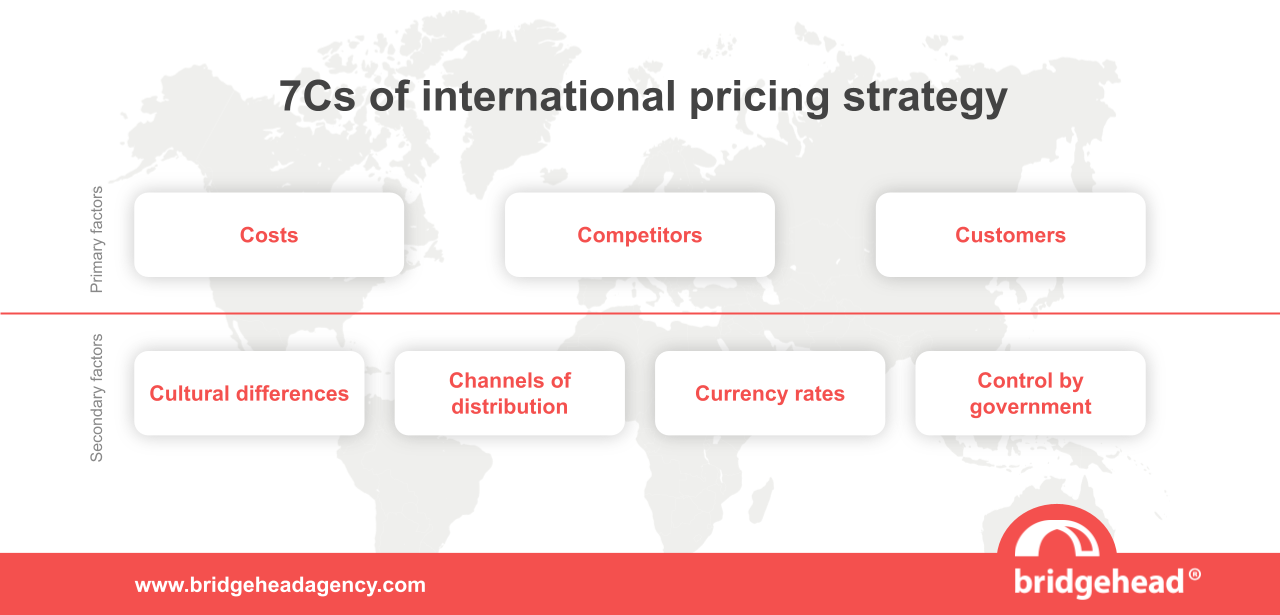Successful international expansion doesn’t happen by chance or a stroke of luck. It requires detailed research, planning and the development of a concrete go-to-market (GTM) strategy. In our blog, the importance of a GTM strategy we revealed the 5 pillars which collectively form an effective GTM strategy. In this article, we’re going to look at “Numbers” to help you create your international pricing strategy. Learn which factors to consider to help you decide how much to charge for your products/services in your new target market.
When it comes to pricing, you’ve already established a pricing strategy in your domestic market. Developing an international pricing strategy is more complex because you are throwing unfamiliar factors into the mix, such as: currency fluctuations, regulatory and compliance variations, cultural differences. A good starting point is to look at internal (goals, objectives, brand positioning, product attributes) and external factors (demand, competitors, market trends) as these will influence your pricing strategy. A useful guide to look at is the 7Cs of international pricing model to ensure you cover all areas.
7Cs of international pricing strategy

Dr. Chris D’Souza developed the 7Cs of international pricing1. These are primary and secondary factors which you’ll need to account for before setting your international pricing strategy.
- Costs – firstly, it’s critical to get a handle on all your costs related to your product/service offering. This includes development, manufacturing/production, packaging, distribution, storage, marketing, freight, tax, custom duty.
- Competitors – understanding the competitive landscape is another key element. From a brand positioning perspective, understand where you sit within the positioning map in relation to your competitors. E.g., premium vs economy, as this will influence prices.
- Customers – at this stage in formulating your GTM strategy, you should have a firm understanding of your target customers and how much they are willing to pay for your product/service. If you don’t know, you need to find out.
- Cultural differences – this comes back to understanding the local culture and your target customer’s perception of your brand versus your competitors. For example, Starbucks deploy huge price variations due to market positioning: in Russia, they position themselves as a luxury high-end coffee house, whereas in the US, their target market is “Regular Joes”; therefore, their US prices are relatively lower than in Russia.
- Channels of distribution – how many organisations are involved in your global supply chain? For example, agents, importers, wholesalers, retailers. The more companies which are involved, the higher your costs.
- Currency rates – handling multiple currencies means that you are vulnerable to exchange rate fluctuations. This should be factored into your pricing strategy.
- Control by government – government regulations could potentially add to the complexity. For example, in the UK, there is a national minimum wage enshrined in law, so regardless of the size of your business, you would need to factor this in for UK workers.
International pricing strategies
Once you have accounted for the 7Cs, there are different pricing strategies to choose from. Let’s look at each strategy in greater depth2.
Penetration pricing
Penetration pricing is commonly used to attract new customers by offering a lower price than your competitors. This is often used when a new product/service attempts to “penetrate” a competitive market. We saw the streaming platform, Disney+ deploy this tactic when they entered the streaming market. Against established players, such as Netflix, Disney+ offered a reduced annual subscription price of £50 when they entered the UK market in March 2020, to entice new customers.
Economy pricing
Economy pricing is a volume-based pricing strategy. Your product is priced low to gain revenue through volume purchases. The German food discounters Aldi and Lidl both capitalise on economy pricing to drive their ambitious global growth plans.
Premium pricing
This marketing tool is about charging high prices in the hope that the higher price will give the impression of a higher quality. When considering this strategy, a brand which immediately springs to mind is Apple. Their products including iPhones, iPads, MacBooks are more expensively priced than their competitors. The perception is that Apple products are of higher quality because of these premium prices.
Price skimming
This is where you enter a market charging a high price, but once competitors follow, you lower your prices. This tactic has been deployed by Sony’s PlayStation game consoles. When Sony launches a new PlayStation console, they initially charge a high price, but the price is gradually decreased over time as competitors launch rival consoles.
Promotional pricing
Promotional pricing is a method where you offer a price reduction for a limited time in order to boost sales. These promotions are usually supported by marketing campaigns. These could be flash sales (Black Friday), buy one, get one free (BOGOF) deals, often seen in supermarkets or seasonal offers (Boxing day/January sales).
Psychological pricing
This strategy integrates sales tactics and pricing. It utilises techniques to form a psychological or subconscious impact on consumers. Various common tactics are [3]:
- Artificial time constraints – “One Day Only” This triggers urgency. If customers don’t act now, they will miss out. Black Friday springs to mind here. The truth is though, there will always be another sale.
- Charm pricing – Often used by estate agents, car dealers, and retailers. Basically, anything you see ending in “9”, Western-based consumers read from left to right, if you see something which is £9.99, you will perceive the price being closer to £9 than £10.
- Innumeracy – double discounting is commonly used here, for example, an item may be advertised as 25% off, then the company will offer an additional 10% off. Customers might perceive this as a total of 35% off, whilst the reality is, the 10% is off the discounted price.
- Price appearance – psychologically, longer prices appear more expensive than shorter prices because it takes us longer to read it. Restaurants often display prices in smaller fonts and omit “0s” and pound signs, this makes the prices look shorter, therefore cheaper.
Versioning
The idea behind versioning is to use differential pricing by offering different versions of a product or service. We’re all familiar with the Goldilocks and the three bears’ story: the porridge was either too hot, too cold, or just right. Let’s apply this principle to your products/services, where you could create a premium, (high quality, faster, priority), or stripped down (lower quality, off peak) versions; or meet unique customer needs (package size, extended warranties). This technique is famously used by the airline industry, where passengers have the option to fly in either economy, business or first class.
Sandwich Pricing
This tactic involves “sandwiching” your competitor’s price between two of your own products. The idea is you have a more expensive version with more benefits, a cheaper version with less features, as well as a mid-priced offering. This tactic is designed to drive customers towards your mid-priced item.
Competitive pricing
Here, you are setting your prices based on your competitor’s prices. This is often used where the product is largely homogeneous, and when you are operating in a highly competitive market. A classic example is between Pepsi and Coca Cola. Both brands compete over pricing, quality, and features. Their prices remain similar.
Value pricing
Value pricing is where you price your product or service based on what it is worth to your customer based on their needs, perceptions, and preferences. This tactic largely ignores competitor prices and your own costs. This strategy is often adopted by restaurants, art, and consultancy services.
Price elasticity of demand
Another aspect to take into consideration is price elasticity of demand. This refers to how price changes affect consumer demand. If your customers are still buying your product despite price increases, your product is inelastic. On the contrary, price changes affect elastic products e.g., clothing, soft drinks, cars. In an ideal world, your product or service should be inelastic. Examples of inelastic products could be fuel, tap water, cigarettes, and products by Apple.
Creating your international pricing strategy
It goes without saying, it’s important to regularly review your pricing and you may use a combination of the pricing strategies. Paul McIntosh, Founder of Bridgehead advises, “At the end of the day, you have to find a price that your customer is willing to pay, whilst offering any middlemen such as wholesalers/retailers the margins they desire. You must cover your own internal costs, as well as hit your margin targets. Setting a pricing strategy is a team effort and a fundamental part of your overall GTM strategy.” Make sure your go-to-market strategy is successful – we will develop & implement it, achieving quantifiable results within 90 days, guaranteed. Contact our specialists today.
Sources:
1. CMA Australia
2. Inc.
3. Recur
Let’s connect










